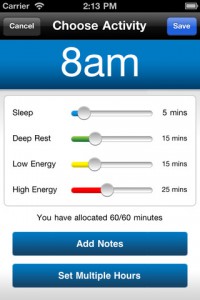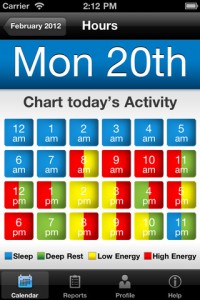Dr. Esther Crawley recently announced the availability of a new iPhone app for CFS patients: ActiveME. The app is designed to help patients monitor their activity levels with the goal of identifying “boom and bust” energy cycles. I decided to take it for a test drive.
 The app has a very easy to use interface. When you open the app, you see a chart for that day with a box for each hour of the day. Clicking an hour box brings up a slider screen where you set the level(s) of activity you sustained in that hour. Multiple hours can be set at once, saving the tedium of entering many hours of the same activity level. You can also enter notes when setting activity levels, such as what type of activity you were doing during that hour.
The app has a very easy to use interface. When you open the app, you see a chart for that day with a box for each hour of the day. Clicking an hour box brings up a slider screen where you set the level(s) of activity you sustained in that hour. Multiple hours can be set at once, saving the tedium of entering many hours of the same activity level. You can also enter notes when setting activity levels, such as what type of activity you were doing during that hour.
 At the end of the day, you have a chart that shows your activity intensity throughout that day. You can email daily or weekly reports to your own email address or someone else’s (although that is not recommended for security reasons). However, the reports only provide a simple line graph of the high energy activity you have entered. Your data on sleep, deep rest and low energy time is not shown in the graph report.
At the end of the day, you have a chart that shows your activity intensity throughout that day. You can email daily or weekly reports to your own email address or someone else’s (although that is not recommended for security reasons). However, the reports only provide a simple line graph of the high energy activity you have entered. Your data on sleep, deep rest and low energy time is not shown in the graph report.
Security for your data is basic. You can set a password to protect the data, and all your data stays on your phone. It is not synced to a server or iCloud. While this is good for security, it does mean that if you lose your phone you will also lose your data. There are no backups.
One difficulty I have with this app is the definition of activity levels, which are just not sensitive enough in my opinion. Low energy activity is defined as “television that you are not engaged in (not concentrating on); listening to music; watching animals outside; doodling; hobbies that do not require concentration; such as easy routine cooking jobs.” This is just not clear enough. What is “concentration”? I knit a great deal, and at multiple levels of difficulty. But all knitting takes some degree of concentration in terms of paying attention to what you are doing. This is true of all the sedentary hobbies I can think of. And “easy routine cooking jobs” may not require a great deal of concentration, but do require standing. Is it still low energy?
The definition of high energy activity is even more troublesome. The app defines three types of high energy activity:
1. Physical activity: walking; cycling; sports; dancing, etc. If you are severely affected this will include activities such as toileting and showering. 2. Thinking activity: this includes any activity that requires concentration e.g. work; school work; reading a book; any computer time; talking with friends; visiting doctors; watching TV that you are concentrating on or engaged in. 3. Emotional activity. This includes time when you are anxious or worrying. Some people use this for time when they are excited or nervous.
There are so many problems with this definition. What if you are anxious but lying down listening to music? Is that high energy or low energy? Why is concentrating on TV categorized the same as walking? In my experience, there is a huge difference in the energy cost of those two activities. The same is true for talking with friends, reading a book, or even writing this blog post. All of those activities are lower energy for me than walking, as well as different energy intensities from each other. Obviously, the user can define the low and high energy classification however he or she wants. Activity tolerance varies so much from person to person, customizing the definitions seems essential to me. But having only two categories – low vs. high – is pretty simplistic.
My big disappointment with the app is that there is no way, other than entering notes, to track symptom levels. The app is supposed to help the user identify “boom and bust” cycles. But all it really tracks is how often you engage in “high energy” activities. The true value in tracking one’s activity is tying it to symptoms. For example, I might see that using the computer for more than an hour causes increased symptoms, and that might motivate me to set a computer time limit. I might also see that I can do easy cooking for 30 minutes without symptoms, longer than I might have predicted on my own. But without tracking both activity and symptoms, it will be very challenging for me to derive meaningful data from activity tracking alone. It is seeing the relationship between activity and symptoms that will really help a person identify a boom/bust cycle.
I’ve been tracking my activity, symptoms and medications for years using a paper chart adapted from Bruce Campbell’s program. While I love the idea of being able to track my activity on the iPhone, ActiveME just doesn’t provide the level of detail and data that would be helpful to me. At $1.99, it’s not too much of an investment to try it out – if you have an iPhone. No word on versions for other mobile platforms. Update: In an email, Louise Wilson said that the iPhone platform was chosen as the most widely available. If the app generates any income, then developing an Android version and incorporating user suggestions will be considered.
Overall, I think ActiveME is a good first attempt at an app to help with pacing. But I think it will be of little use to those who want to track their symptoms and post-exertional malaise in response to activity.

Thanks Jennie for the review – something like this is sorely needed. I imagine its only a matter of time before a really good one is developed.
Interesting concept, thanks for the valuable review. I agree that it has little value while it has such limited activity categories. Perhaps they need to look at user defined categories where the user can create their own list activities for each category eg low, mid-low, medium, med-high, high or energy demanded 10%, 20%, 30% etc
Thanks for the review. When I first heard about this app, I thought it sounded too difficult. Based on what you described, I think I could get good use out of it. But I do wish there were more categories.
When I’m bad, a small amount of exertion is a problem. I a) Go dizzy b) Shake c) Jump and jerk when sleepy d) Have palpitations e) Be worried, frightened and expect (hope?) to die.
When not so bad some of these return. I can find no correlation with my activity levels or anything else.
Is the data you enter get transmitted back to the development team to study?
No, Anne. The data all stays on your phone. The app is designed for use with your healthcare provider, but you have to manually generate the reports and send them to your or another’s email.
I think I would be concerned that by merely downloading this app you are contributing to a quotable stat for those of a psych persuasion.
Anne R’s concern is also important.
This is actually a very dangerous app for patients, a trojan horse no less in my opinion.
I downloaded this app and it just crashes when I try to load it. Very dissapointed
Pingback: ME/CFS Buzz (March 12th 2012) | Phoenix Rising